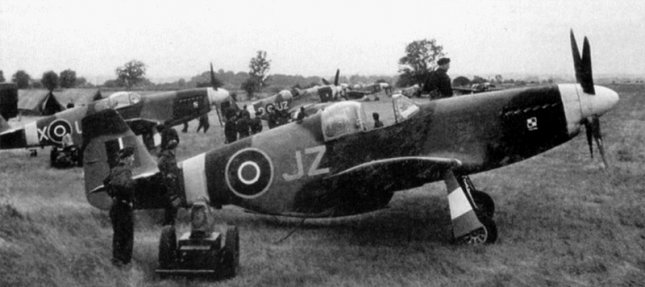Every aircraft nut is familiar with the P51, mostly with the D model, which was the definitive production model. It played a great part in the final years of the war, providing fighter escort for long-range bombers.
Few people actually realise that the first aircraft were built to RAF specification:
From Wiki:
The North American Aviation P-51 Mustang was an American long-range, single-seat fighter and fighter-bomber used during World War II, the Korean War and other conflicts. The Mustang was conceived, designed and built by North American Aviation (NAA) in response to a specification issued directly to NAA by the British Purchasing Commission.
The prototype NA-73X airframe was rolled out on 9 September 1940, 102 days after the contract was signed and, with an engine installed, first flew on 26 October 1940.

RAF (309) Polish squadron Mustang Is with Spitfire Bubble canopy
The Mustang was originally designed to use the Allison V-1710 engine, which had limited high-altitude performance. It was first flown operationally by the Royal Air Force (RAF) as a tactical-reconnaissance aircraft and fighter-bomber (Mustang Mk I).

Western USA Model: P-51A-10NA
The addition of the Rolls-Royce Merlin to the P-51B/C model transformed the Mustang's performance at altitudes above 15,000 ft, giving it a much better performance that matched or bettered almost all of the Luftwaffe's fighters at altitude.

P-51A

The Merlin-engined P51B

P51C "Tuskagee Airmen"

Heart of the P51C and D: The Rolls-Royce Merlin

RAF Mustang MkIII - note the Spitfire-type curved cockpit canopy
This one is from 19 Squadron

American style plain cockpit canopy and the" quarterlight" window, which was sometimes painted out
From late 1943, P-51Bs (supplemented by P-51Ds from mid-1944) were used by the USAAF's Eighth Air Force to escort bombers in raids over Germany, while the RAF's 2 TAF and the USAAF's Ninth Air Force used the Merlin-powered Mustangs as fighter-bombers, roles in which the Mustang helped ensure Allied air superiority in 1944.

The P-51 was also in service with Allied air forces in the North African, Mediterranean and Italian theaters, and saw limited service against the Japanese in the Pacific War. During World War II, Mustang pilots claimed 4,950 enemy aircraft shot down.
At the start of the Korean War, the Mustang was the main fighter of the United Nations until jet fighters such as the F-86 took over this role; the Mustang then became a specialized fighter-bomber. Despite the advent of jet fighters, the Mustang remained in service with some air forces until the early 1980s. After World War II and the Korean War, many Mustangs were converted for civilian use, especially air racing, and increasingly, preserved and flown as historic war-bird aircraft at airshows.
Link to post-war SAAF Flying Cheetahs in Korea blog entry



A fine aircraft indeed, and that was credited also with praise from RR Stanford Tuck, in the novel Fly for your Life, which I greatly enjoyed reading many years ago...
ReplyDeleteI'm building a Tempest and a Horsa glider for the D-Day commemoration game 10 May 2014 at the moment, Someone posted some pics of Mark IIIs on FB, and I googled "invasion paint schemes" and got carried away...
DeleteJust to be clear, that "Spitfire canopy" is properly called a "Malcolm Hood", made by R Malcolm & Co.
ReplyDeletehttp://www.aerofiles.com/malcolm-hood.html